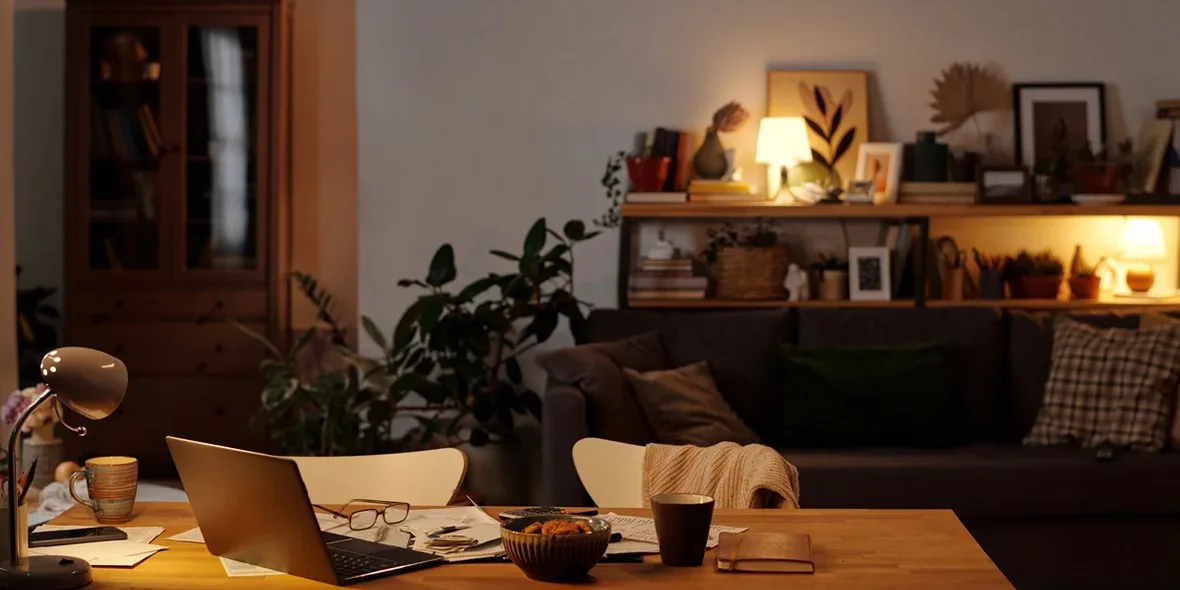
How to Make any Apartment Really Cozy: Proven Methods
Buying an apartment is often seen as the final step in a long journey of saving money and choosing the right property, but in reality, it’s just the beginning. Now, the new owners face the task of truly making the place their own by adding a touch of personality and, of course, coziness.
Even new-build apartments with developer-finished interiors often feel cold and impersonal, since they’re based on standard templates, even if buyers are sometimes allowed to choose materials and colors. Pre-owned apartments come with their own set of challenges: wallpaper, tiles, and color schemes are all chosen to someone else’s taste, which rarely aligns with your own and can leave you feeling like a guest in your own home.
In this article, we’ve gathered practical and accessible ways to bring warmth and comfort into any apartment, regardless of its initial condition or size. After all, everything from lighting to fabric texture affects how cozy your home feels.
Wallpaper for a Cozy Apartment
Even if you bought a new-build and were directly involved in picking the wallpaper, there’s no guarantee you’ll be happy with the final result. It’s even worse if the walls were simply painted with standard paint — painted walls often lack texture and depth. Wallpaper, on the other hand, can dramatically transform a space and change how it’s perceived through patterns and design.
When choosing wallpaper, the first thing to pay attention to is the material. While it may not seem like the most important factor for creating a cozy vibe, skipping this step can result in vibrant colors fading and losing their charm quickly.
Main types of wallpaper:
- Non-woven wallpaper. These are great at hiding minor wall imperfections like cracks and dents. They’re durable and breathable, making them suitable for painting. The only downside is a limited selection, especially in the budget range.
- Vinyl wallpaper (on paper or non-woven backing). These consist of a base layer and a top PVC layer. They’re easy to clean, making them ideal for kitchens and bathrooms. However, they’re difficult to remove, and PVC has its environmental and breathability downsides.
- Paper wallpaper. A classic, lightweight, eco-friendly option. Available in all price ranges, but they’re not very durable and don’t hold up well against moisture or direct sunlight.
- Textile and natural wallpaper. These have a decorative top layer made of fabric or natural materials. They look luxurious, but are sensitive to moisture, prone to stains, and often expensive.
Wallpaper color directly affects how a room feels: light tones visually expand the space, while dark ones create a more intimate, cozy vibe, though they’ll require additional lighting.
Small patterns work well in compact rooms — they don’t overwhelm or visually shrink the space. Large patterns, on the other hand, serve as focal points. But if you’re unsure about having a pattern at all and find plain or gradient wallpapers boring, try experimenting with textured wallpapers (like faux plaster, fabric, or wood).
Lighting as the Foundation of a Home’s Atmosphere
Modern lighting fixtures come with an important feature — light color temperature. It’s measured in kelvins (K) and defines the color spectrum of the emitted light. Here’s how it typically breaks down:
- 2700–3000 K — white light with a warm yellowish tint. Ideal for most areas of a home or apartment, except perhaps the kitchen and bathroom, though that’s subjective.
- 3500–4100 K — neutral white that mimics bright daylight. Best suited for workspaces and therefore often used in offices.
- 5000–6500 K — cool white. A specific and very bright spectrum with a bluish hue that feels cold. Commonly found in medical facilities and high-precision industries, but it can also be used in homes.
Other key lighting specs:
- Luminous flux. This shows how much light a bulb emits — basically its brightness, technically speaking. It’s measured in lumens (lm), and the more lumens, the brighter the light. Ignore this, and your cozy living room might end up looking like a sketchy basement. The basic categories:
- 200–400 lm — for accent or spotlighting.
- 600–800 lm — for bedside or table lamps. For general room lighting, you’ll want to combine multiple of these.
- 1000+ lm — for main room lighting. This level is usually enough to light up a whole room.
- Color rendering index (CRI or Ra). A score that shows how naturally colors appear under this lighting, rated from 0 to 100. For homes, go for fixtures with CRI > 80, though 90+ is ideal.
Sounds techy? Let’s break it down with a classic home office setup. For general lighting, go with a bulb over 1000 lumens and a warm tone of 3000 K. For your desk, use a medium-brightness lamp (600–800 lumens) with neutral white light (up to 4000 K). Since this directly impacts your workspace, go for a CRI of 90+ to reduce eye strain.
In general, layered lighting — combining desk lamps, floor lamps, shelf lighting, and task lights — is a smart move. It adds visual depth to the space and helps highlight specific features, like artwork or alcoves. Dimmer switches and smart bulbs are perfect for this too, letting you adjust brightness and color temperature to match the vibe.
Cozy Furniture for Your Apartment
Furniture is the backbone of any interior. This is especially important in new-build apartments, where there’s often nothing but bare walls. Things aren’t much better in the secondary market — even if previous owners left some furniture behind, its condition and how well it matches your taste is a big question mark.
To create a cozy vibe, soft furniture with rounded shapes works best. A big boxy sofa might technically be soft, but it looks bulky, especially in a smaller room. It feels like dropping a kettlebell onto a pile of cotton: it dominates the space and weighs down the atmosphere. In contrast, furniture with legs or open spaces under the arms or base feels lighter and adds volume without stealing attention.
The exception here is multi-functional furniture, like sofas with storage, folding tables, or lift-up beds. These pieces might be bulky, but if they’re done in light colors, they won’t feel overpowering.
Materials matter too. Smooth, cold surfaces like gloss, metal, or glass can feel sterile and unwelcoming, while wood, fabric, leather, and rattan instantly warm up the space.
Here’s what works well for a cozy look:
- Natural or tinted wood (doesn’t have to be expensive — even veneer gets the job done).
- Soft upholstery with a noticeable texture (like velvet, bouclé, or rough-weave fabric).
- Matte finishes instead of glossy ones — especially on cabinets and kitchen fronts.
- Woven, fabric, or leather elements (like poufs, armchairs, or armrests).
Textiles and Fabrics for the Apartment
Textiles — quite literally — soften the edges of even the boxiest room. Strict lines and sharp styles become more inviting when paired with something like a round, high-pile rug. Rugs in general are a super useful tool: they help visually divide the space into zones, like separating a living and dining area in a studio apartment.
It’s important to remember that interior design isn’t just about how things look — it’s also about how they feel, including to the touch. That’s where textured textiles come in to create a sense of tactile comfort. Fabrics like velvet, wool, bouclé, and soft cotton are perfect for this.
Examples of fabric texture combos:
- A chunky knit throw with pillows in smooth cotton covers.
- A soft, long-pile rug on top of wooden floors.
- Velvet-upholstered armchairs next to linen curtains.
Of course, texture isn’t everything. Color comes next on the list — and not in second place when it comes to impact. Having a few sets of bedding or furniture covers lets you easily switch up the mood of your home, for example, with the seasons. In summer, light and airy shades of blue and yellow feel refreshing. In fall and winter, you can create a warmer vibe with wood-inspired tones and variations of orange and red.
Some working color schemes:
- Base background. A soft foundation color like grey, dusty pink, or warm white is neutral enough not to get boring and makes a great backdrop.
- Monochrome with nuances. Try layering different shades of the same color in varying textures. For example, light beige walls paired with peach-beige curtains in a deeper tone.
Speaking of curtains, they do more than just filter light — they visually warm up a room, muffle street noise, and add softness overall. Floor-to-ceiling curtains can make a room look taller. Heavier fabrics add weight and coziness, and when layered with sheer tulle, give you easy control over natural light throughout the day.
Details That Create a Cozy Home
Plants are a crucial part of interior design. They breathe life into a space and bring a sense of connection to nature. Beyond aesthetics, plants serve a practical purpose too — they can improve the indoor climate. For example, Sansevieria (aka snake plant) removes formaldehyde and related compounds from the air during the day and, unlike many others, doesn’t release them back at night.
Ways to place plants in your home:
- Large floor plants to help zone the space and fill empty corners.
- Arrangements of small succulents on window sills, shelves, or desks.
- Culinary and medicinal herbs in the kitchen — both decorative and useful for cooking or tea.
That said, it’s important not to turn your home into a jungle. Too many plants can visually overwhelm a space, and even affect your health. There’s a lot of hype around oxygen production during photosynthesis, but the process is cyclical. During the day, leaves produce oxygen under sunlight. But at night, the cycle reverses: plants consume oxygen and release carbon dioxide. That’s why overloading your bedroom or any frequently used space with plants is not recommended.
Personalizing your space also plays a big role in creating comfort. Whether it’s a souvenir from abroad or a photo of someone close, personal touches add warmth — even if they don’t perfectly match the overall aesthetic. What makes a home feel cozy?
- Photos and posters in frames on shelves, dressers, or walls.
- Personal collections — records, ceramics, books, postcards.
- Vintage pieces, antiques, and anything with a story. Handmade items fall into this category, too.
Conclusion
Cozy isn’t just what happens when the furniture and wall colors “kind of work together.” It’s the result of thoughtful choices in materials, lighting, fabrics, and details. Sure, some people just go with their gut and manage to create something nice, but often, it still feels like something’s missing.
The right wallpaper sets the tone and reshapes how you perceive space. Smart lighting lets you shift the mood with the time of day. Soft, rounded furniture with natural textures gives the room warmth. And finally, living plants and personal objects return that feeling of “this is my place” in an otherwise chilly world.
Author
I write informative articles about real estate, investments, job opportunities, taxes, etc.























